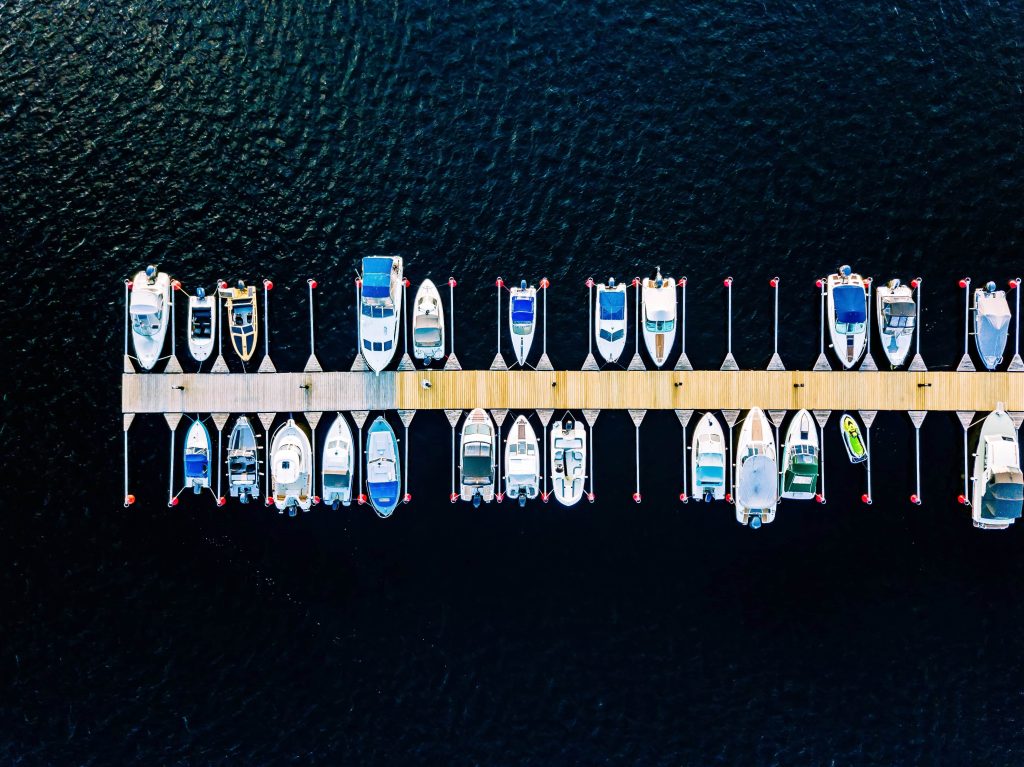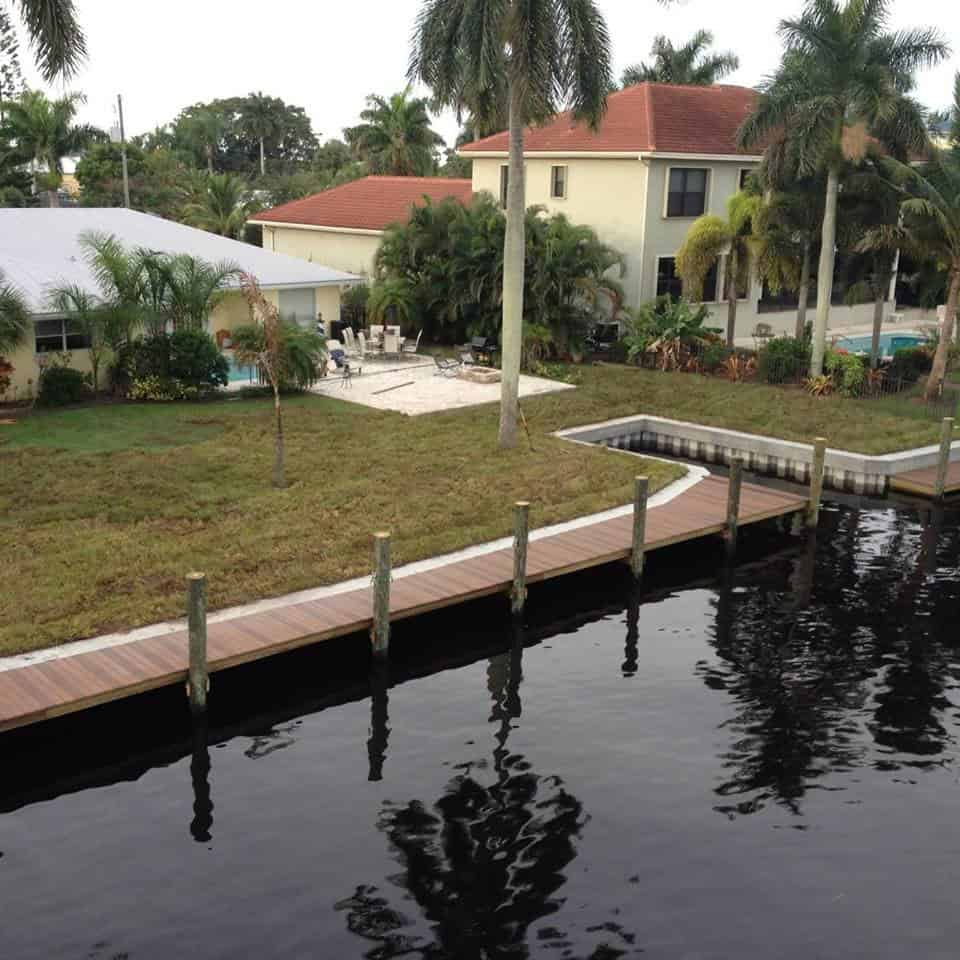Read This Before you Build your Boat Dock
Building a dock in St Lucie County or the surrounding area? Don’t just slap some boards together and hope for the best. Over the past 25 years, we’ve watched too many waterfront property owners learn expensive lessons about dock construction. Your dock isn’t just a place to tie up your boat; it’s the bridge between your backyard and everything great about waterfront living.
Here’s what we’ve discovered: the owners who spend the least money upfront usually end up paying the most over time. That bargain dock becomes a money pit when you’re constantly fixing loose boards, replacing rotted sections, or worse, watching the whole thing collapse during the first big storm.
Thoughtful dock planning starts with understanding what you’re working with. Skip this homework, and you’ll pay for it later.
Your Water Conditions Call the Shots
Every waterfront spot has its own personality. What works great on Lake Smith might be a disaster on the Intracoastal. We’ve seen gorgeous docks turn into expensive lawn ornaments because nobody bothered to check the seasonal water levels.
Get the Depth Right
Most people measure water depth once and think they’re done. Wrong move. That perfect depth in May might leave your boat high and dry come August. We’ve had customers call us in panic mode because their brand-new dock became useless when summer drawdowns hit.
Talk to your neighbors—the ones who’ve been there through multiple seasons. They’ll tell you stories about water levels that’ll make you rethink your dock height. Better to hear those stories before you build than after.
Bottom Conditions Matter More Than You’d Think
Sand bottoms may look easy, but they shift constantly. Mud bottoms seem forgiving until your pilings start sinking like they’re in quicksand. Rock bottoms fight you during installation but hold forever once you get through them.
Last month, we removed a DIY dock where the owner assumed he could judge the bottom conditions just by looking. His pilings tilted so badly within two years that the dock became dangerous. A simple soil test would’ve prevented the whole mess.
Dock Types: Match Your Choice to Reality
Marketing brochures make every dock type look perfect. Reality tells a different story. Each design works great in some situations and poorly in others.
Fixed Piers Work When Water Stays Put
Fixed piers give you rock-solid stability. No bouncing around when you’re loading coolers or fuel. You can bolt boat lifts directly to them, run electrical lines easily, and build them as wide as you want.
But here’s the catch—they only work when water levels stay predictable. Too low, your boat can’t reach deep water. Too high, your dock disappears. Professional boat dock installation for fixed systems means getting the elevation exactly right the first time. Miss by six inches, and you’re looking at major modifications.
Floating Docks Adapt, But They’re Not Perfect
Floating docks rise and fall with water levels. Sounds perfect, right? Usually, yes. They cost less to install than fixed systems and work great in most situations. Modern floating docks can support way more weight than people expect.
The problem comes with anchoring. We’ve seen floating docks break loose during storms and cause thousands in damage to other boats and property. Poor anchoring turns your dock into a battering ram. Good anchoring keeps it positioned without fighting the natural up-and-down movement.
Pile-Supported Floating Systems Give You Both
These hybrid setups utilize vertical guides that allow the dock to float up and down while preventing sideways drift. You get floating dock adaptability with fixed pier stability. They work particularly well in areas with moderate water level changes.
Installation gets tricky because everything must align perfectly. Binding guides defeat the whole purpose and can damage the dock during operation.
Materials: What Works vs. What’s Marketed
Every material has pros and cons. Don’t believe the marketing hype—here’s what actually happens in the real world.
Pressure-Treated Wood: Old Reliable with Baggage
Wood costs less upfront and has a natural appearance. Any carpenter can work with it, and you can easily modify it. Modern pressure treatments are more effective at handling rot and bugs than older methods.
But wood needs attention. Regular staining, periodic board replacement, and constant inspection become part of your life. We’ve seen well-maintained wood docks reach the 20-year mark, but neglected ones often require major work within five years. That “cheap” wood dock might cost more than aluminum when you add up maintenance over its lifetime.
Aluminum: Pay More Now, Save Later
Aluminum docks laugh at everything water throws at them. No rot, no warping, no painting ever. Many systems snap together modularly, making expansion or reconfiguration simple.
The upfront cost stings, but the long-term math usually works out. Professional boat dock installation becomes critical with aluminum, as poor connections can lead to corrosion problems and structural failures. Done correctly, aluminum docks run 30+ years with minimal fuss.
Composite Materials: Engineered Performance
Composite decking resembles wood but behaves like plastic. It resists moisture, bugs, and UV damage while staying slip resistant. Most manufacturers back these products with warranties of 15-25 years.
Quality varies dramatically. Cheap composites fade, crack, and become slippery when wet. Premium products perform as advertised but cost accordingly. Research specific products carefully rather than assuming all composites perform equally.
Installation Separates Success from Disaster
Excellent materials and innovative design mean nothing if installation cuts corners. We’ve rebuilt numerous docks where poor construction compromised otherwise solid systems.
Foundations Make or Break Everything
Foundation problems show up as tilting, settling, or complete collapse. These issues rarely improve—they get worse until reconstruction becomes necessary. Professional boat dock installation begins with a thorough soil assessment and a foundation design tailored to your specific site conditions.
DIY foundation work often fails because homeowners lack the necessary equipment and experience to accurately evaluate soil conditions. The installation savings are frequently offset multiple times over when foundation problems necessitate professional repairs.
Permits Slow You Down, But Keep You Legal
Dock construction involves federal, state, and local agencies with overlapping jurisdictions. The Army Corps of Engineers handles navigation issues. State environmental departments focus on water quality and habitat protection. Local building departments ensure structural safety.
Professional marine construction companies interact with these agencies daily. They know which permits apply to your situation and how to prepare applications that get approved. Trying to skip permits often results in stop-work orders and expensive modifications.
Maintenance: Stay Ahead of Problems
Regular maintenance prevents minor issues from becoming expensive disasters. Proactive care costs far less than emergency repair and keeps your dock functional longer.
Summer Care Prevents Big Problems
Cleaning your dock regularly is essential, as algae buildup can create dangerously slippery surfaces. Inspect all hardware for signs of corrosion or loosening due to thermal expansion. Watch for changes in stability or elevation that might indicate foundation issues.
Document problems as they develop. Early identification allows for repairs during favorable weather conditions, rather than in emergency situations when contractors charge premium rates.
Common Problems We See Repeatedly
Understanding typical dock problems helps you identify issues early and determine whether to repair or replace them.
Foundation Issues Start Small, End Big
Foundation problems appear as tilting, settling, or general instability. They worsen over time and can affect your entire dock system. Early intervention often prevents minor foundation issues from requiring complete reconstruction.
Professional boat dock repair services have specialized equipment and proven techniques for foundation work. We’ve stabilized foundations that seemed hopeless and extended dock life by decades.
Hardware Failures Create Safety Hazards
Marine environments can corrode metal hardware, especially when different metals come into contact with each other. Loose or corroded connections become safety hazards and can cause complete structural failure during storms or heavy use.
Regular hardware inspection and replacement prevent minor issues from causing significant damage. Professional services understand marine-appropriate materials and installation techniques that prevent galvanic corrosion.
Why Professional Services Pay Off
Professional marine construction brings expertise, proper equipment, and accountability that DIY approaches can’t match. Modern dock systems and regulatory requirements make professional services increasingly valuable.
Design Knowledge Prevents Expensive Mistakes
Professional marine construction companies offer comprehensive site assessment and design services, taking into account all relevant factors—environmental conditions, regulatory requirements, and long-term property objectives.
Our 25+ years working with hundreds of waterfront properties provide insights into what works in specific conditions and what commonly fails. This knowledge enables property owners to avoid costly mistakes and achieve better long-term results.
Quality Materials and Proper Installation
Professional contractors have access to commercial-grade materials and specialized equipment that is unavailable to homeowners. They understand proper construction techniques and maintain strong supplier relationships, ensuring the use of quality components at competitive prices.
Professional installation includes warranties and insurance coverage protecting property owners from defects or installation problems. This protection provides peace of mind and financial security that DIY approaches can’t offer.
Making Smart Investment Decisions
Choosing the right dock solution requires balancing immediate needs with long-term goals while considering budget constraints and site limitations. The cheapest upfront option rarely provides the best long-term value.
Total Ownership Costs Tell the Real Story
Evaluate dock options based on complete ownership costs, including initial purchase, professional installation, ongoing maintenance, and the expected replacement timeline. More expensive systems with lower maintenance requirements and longer lifespans often provide better value than cheaper alternatives requiring frequent repairs or early replacement.
Consider the impact of your dock choice on property value and waterfront enjoyment. Well-designed, professionally installed docks enhance property value while providing decades of reliable service.
Professional Consultation Saves Money
Consulting with experienced marine construction professionals early in planning saves significant time and money. Professional assessment identifies potential issues and optimal solutions before you commit to specific approaches.
At Harbor Bay Marine Services, we’ve helped hundreds of waterfront property owners navigate these decisions over 25+ years in business. Our experience with diverse waterfront conditions and client needs enables us to provide realistic assessments and practical solutions that meet both immediate needs and long-term goals.
For comprehensive information about waterfront construction regulations and environmental considerations, the U.S. Army Corps of Engineers provides detailed resources for property owners planning waterfront improvements.
Learn more about our boat dock installation services here.
Your waterfront dock represents a significant investment in your property and lifestyle. Taking time to understand your options, evaluating your needs, and work with experienced professionals ensures you’ll enjoy your waterfront investment for years to come. Contact Harbor Bay Marine Services at 772-335-7080 to discuss your specific dock needs and learn how our expertise can help you make the best decision for your waterfront property.






